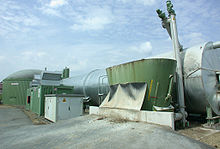Biogas Production and Sources
– Biogas is produced from raw materials such as agricultural waste, manure, municipal waste, plant material, sewage, green waste, wastewater, and food waste.
– Biogas is produced by anaerobic digestion with anaerobic organisms or methanogens inside an anaerobic digester, biodigester, or a bioreactor.
– The gas composition of biogas is primarily methane (CH4) and carbon dioxide (CO2), with small amounts of hydrogen sulfide (H2S), moisture, and siloxanes.
– Methane, the main component of biogas, is also produced in natural environments by methanogens.
– Natural sources of methane include wetland soils, oceans, forest soils, termites, and wild ruminants.
– Industrial biogas production collects biomethane for fuel purposes, such as landfill gas (LFG) or digested gas from anaerobic digesters.
– Biogas production in rural Germany is common, with biogas plants treating farm wastes or energy crops.
– Co-digestion of wastewater with residuals from other industries can increase biogas production.
Bio-gas Plants and Processes
– Bio-gas plants are anaerobic digesters that treat farm wastes or energy crops.
– Anaerobic digesters are air-tight tanks that can be fed with energy crops like maize silage or biodegradable wastes including sewage sludge and food waste.
– Micro-organisms in bio-gas plants transform biomass waste into biogas (mainly methane and carbon dioxide) and digestate.
– Co-digestion of wastewater from the dairy, sugar, or brewery industries can increase biogas production.
– There are two key processes for biogas production: mesophilic and thermophilic digestion, which depend on temperature.
Contaminants in Biogas
– Sulfur compounds, particularly hydrogen sulfide (H2S), are common contaminants in biogas.
– Other sulfur-containing compounds, such as thiols, may also be present in biogas.
– Hydrogen sulfide is corrosive and can yield sulfur dioxide (SO2) and sulfuric acid (H2SO4) when combusted.
– Ammonia (NH3) is produced from organic compounds containing nitrogen and can result in NOx emissions if not separated from biogas.
– Siloxanes can be found in some biogas and can cause engine damage and increased maintenance requirements.
Carbon Dioxide and Methane in Biogas
– Carbon dioxide (CO2) is a byproduct of the anaerobic digestion process and is present in biogas.
– The removal of CO2 from biogas can enhance its calorific value and increase its usability.
– Methane (CH4) is the primary component of biogas and is a potent greenhouse gas.
– Biogas production helps to capture and utilize methane that would otherwise be released into the atmosphere.
– Methane has a higher energy content compared to other hydrocarbons, making it a valuable fuel source.
Benefits of Biogas Production
– Biogas production reduces the emission of greenhouse gases, such as methane and carbon dioxide, into the atmosphere.
– It helps to mitigate climate change by capturing and utilizing methane from various organic waste sources.
– Biogas can replace fossil fuels, reducing dependence on non-renewable energy sources.
– It provides a renewable energy option that can contribute to a more sustainable and circular economy.
– Biogas production also offers waste management solutions by treating organic waste and reducing landfill usage. Source: https://en.wikipedia.org/wiki/Biogas
Biogas is a gaseous renewable energy source produced from raw materials such as agricultural waste, manure, municipal waste, plant material, sewage, green waste, wastewater, and food waste. Biogas is produced by anaerobic digestion with anaerobic organisms or methanogens inside an anaerobic digester, biodigester or a bioreactor.
The gas composition is primarily methane (CH
4) and carbon dioxide (CO
2) and may have small amounts of hydrogen sulfide (H
2S), moisture and siloxanes. The gases methane and hydrogen can be combusted or oxidized with oxygen. This energy release allows biogas to be used as a fuel; it can be used in fuel cells and for heating purpose, such as in cooking. It can also be used in a gas engine to convert the energy in the gas into electricity and heat.

After removal of carbon dioxide and hydrogen sulfide it can be compressed in the same way as natural gas and used to power motor vehicles. In the United Kingdom, for example, biogas is estimated to have the potential to replace around 17% of vehicle fuel. It qualifies for renewable energy subsidies in some parts of the world. Biogas can be cleaned and upgraded to natural gas standards, when it becomes bio-methane. Biogas is considered to be a renewable resource because its production-and-use cycle is continuous, and it generates no net carbon dioxide. From a carbon perspective, as much carbon dioxide is absorbed from the atmosphere in the growth of the primary bio-resource as is released, when the material is ultimately converted to energy.
